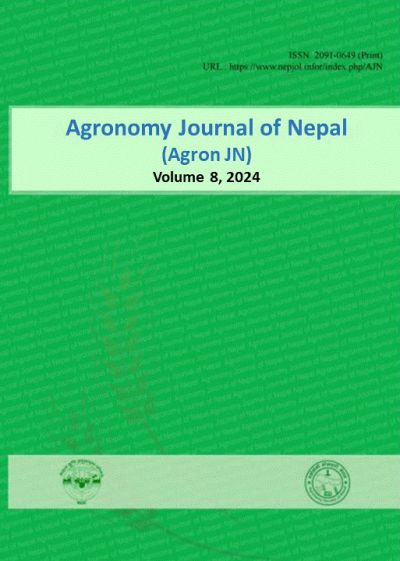Determination of Indigenous Nutrient Supplying Capacity of Soil through Omission Plot Technique in Wheat at Bhairahawa
DOI:
https://doi.org/10.3126/ajn.v8i1.70778Keywords:
Indigenous nutrient supply, k-omission, N-omission, P-omission, wheat productivityAbstract
The rapidly expanding intensive cropping systems in the Terai region of Nepal, combined with imbalanced fertilization, are leading to significant nutrient depletion in agricultural soils, raising concerns about the sustainability of wheat production. To address this issue, a field experiment was conducted at the National Wheat Research Program (NWRP) in Bhairahawa, Rupandehi, during 2018-19 to evaluate the soil’s nutrient-supplying capacity and its impact on wheat grain yield. The treatments included five different nutrient levels: N- omission (75:75:5:1 P2O5:K2O:Zn:B kg ha-1), P-omission (150:75:5:1 N:K2O:Zn:B kg ha-1), K-omission (150:75:5:1 N:P2O5:Zn:B kg ha-1), adequate NPK (150:75:75, N:P2O5:K2O kg ha-1), and adequate NPK+Zn+B (150:75:75:5:1 N:P2O5:K2O:Zn:B kg ha-1). The trial was laid out in a randomized complete block design with five replications, planted in five different blocks of the National Wheat Research Program (NWRP), Bhairahawa, with each block treated as a replication. Data on growth, yield attributes, grain yield, and nutrient uptake were analyzed using the Genstat statistical package. The results showed that plant height, dry matter production, spike length, grains per spike, biological yield, and grain yield variables were significant (P< 0.05), while 1000 grain weight and harvest index were not significant (P>0.05). Total N, P, and K uptake were significant (P<0.05) in different treatments, with adequate NPK showing higher NPK uptake and significantly lower in N- omission treatment. Grain yield was higher in fully fertilized treatment than in nutrient omission treatments, with significantly lower grain yield in N- omission followed by P- omission treatments. Among the major nutrients, nitrogen was found to be the most limiting factor, followed by phosphorus and potassium for wheat. Based on these results, it can be concluded that a balanced amount of NPK nutrients should be supplied to enhance the indigenous nutrient-supplying capacity of the soil and improve wheat productivity in Bhairahawa.
Downloads
Downloads
Published
How to Cite
Issue
Section
License
Copyright (c) 2024 Agronomy Society of Nepal (ASoN)

This work is licensed under a Creative Commons Attribution-NonCommercial 4.0 International License.
ASON permits for free use, distribution and reproduction in any medium if the original work is properly cited and not used for commercial purposes.




